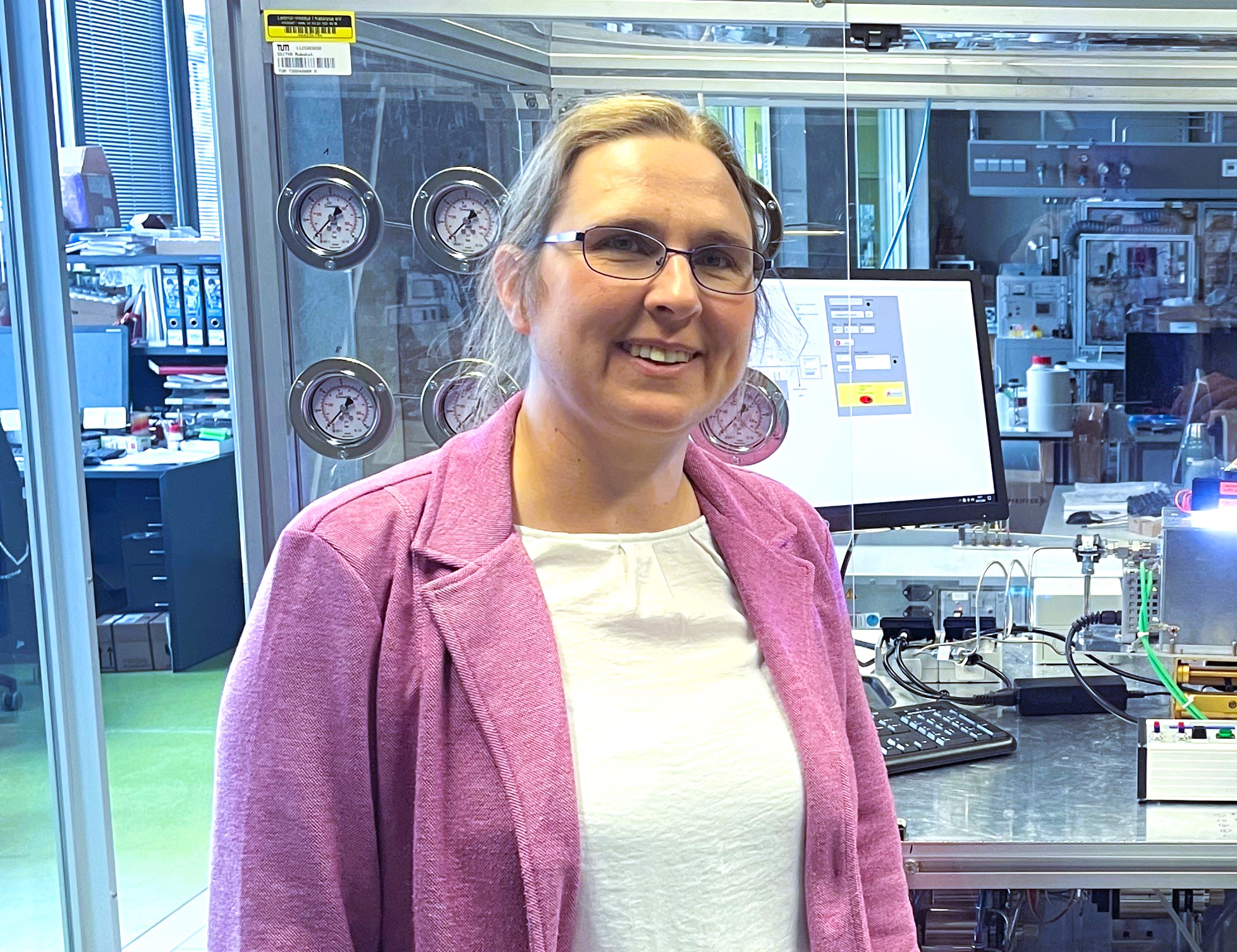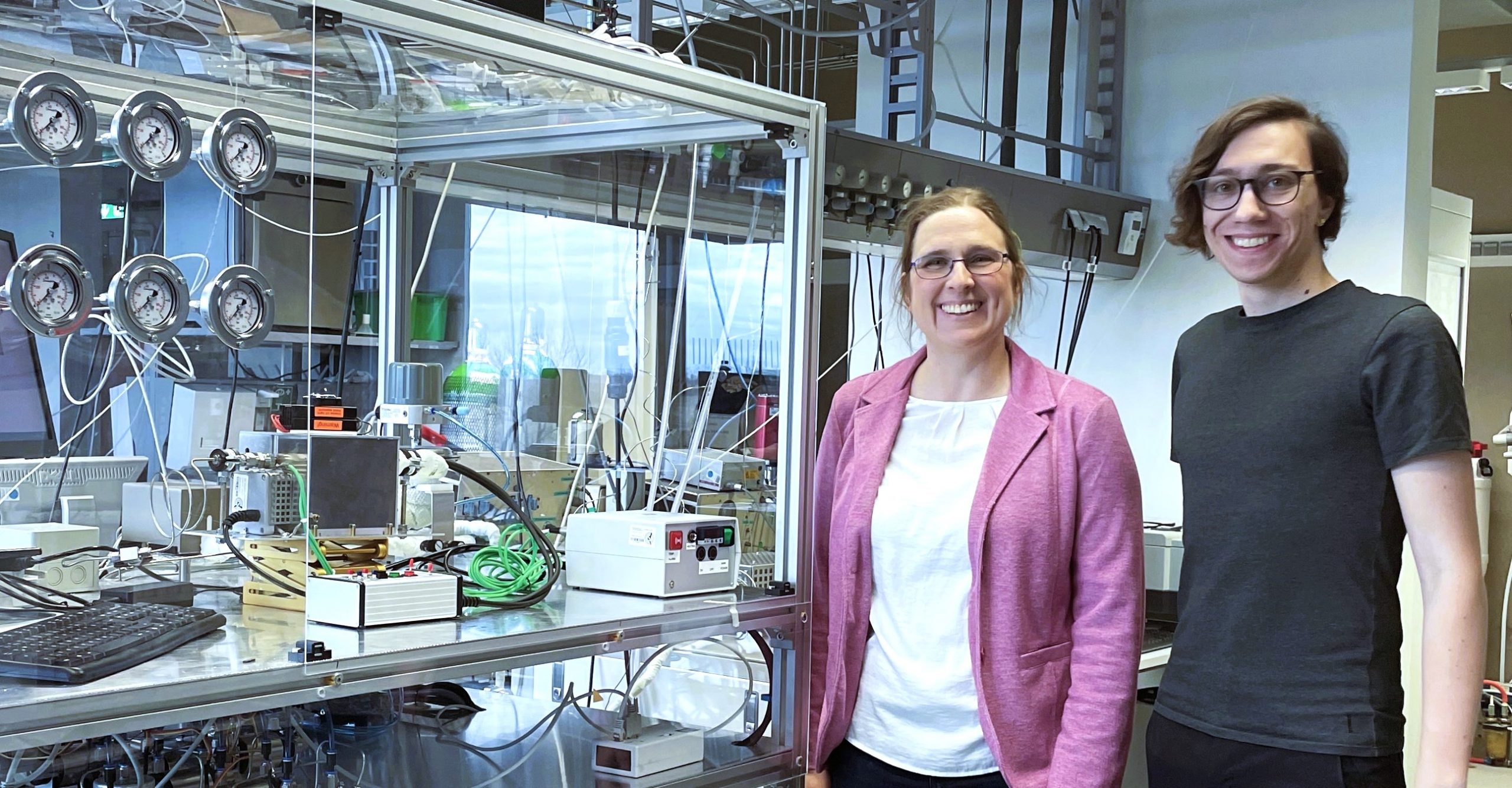
Prof. Jennifer Strunk (Photo: C. Bielke/TUM)
With Jennifer Strunk, Technical University of Munich (TUM) and e-conversion have attracted a researcher with big goals and a zest for action: At the beginning of May 2023, the 43-year-old took over the W3 professorship for “Industrial Chemistry and Heterogeneous Catalysis” and has since enriched the Garching research campus with her research group. The chemist is an enthusiastic photocatalysis specialist working on the conversion of carbon dioxide into industrially usable substances with the help of sunlight. She brings a wealth of experience, great enthusiasm for research, and a strong commitment to scientific dialogue.
What do you want to achieve with your research?
It’s obvious – I want to save the world (laughs). That’s a big goal, of course, but I’m actually trying to do that to some extent. After finishing school, I wanted to find a job in which I could recycle waste and find better ways to utilize it. A job counselor told me that if I really want to find fundamentally new ways, then I should study chemistry. Looking back, I’m very close to my original wish because carbon dioxide is, after all, the ultimate global waste. It’s a small molecule compared to the huge mountains of plastic waste. But if we manage to convert the greenhouse gas carbon dioxide in a way that allows us to use it as a synthetic raw material, then that would indeed save the world.
You have been at TUM since mid-2023 holding the W3 professorship for “Industrial Chemistry and Heterogeneous Catalysis”. Have you and your team already settled down a bit at the Garching Research Centre?
Definitely! I can do research at the best university in Germany – and I’m also part of the e-conversion Cluster of Excellence. That’s great! Thanks to the dual career program at TUM, my husband has also been offered a position at the university as a technical assistant. Together with our four-year-old daughter, we have already settled in well. So far, I have three doctoral students and one postdoc in my team, both physicists and chemists. I really value their respective expertise and perspectives. For my research work at e-conversion, I have already been able to make interesting contacts and initiate collaborations, for example, with my TUM colleagues Marc Georg Willinger, Peter Müller-Buschbaum, Ulrich Heiz, and Ian Sharp.
How do you want to “recycle” climate-damaging carbon dioxide?
Many research approaches are trying to develop “artificial photosynthesis”: Using light to convert carbon dioxide and water into useful products – but faster and more efficiently than natural photosynthesis does. The aim is to produce substances that can be used as fuels or in industrial processes, such as methanol. This is what I’m working on with my research group at TUM: We are researching heterogeneous catalysis and photocatalysis. Our aim is to use light as an energy source, sunlight or efficient LEDs, for example, to recycle the greenhouse gas carbon dioxide for chemical production with the help of a suitable catalyst. In our case, we recently also started using copper-based catalysts.
What are the challenging steps involved?
To answer this, we have to dig deeper into chemistry. We basically use the same catalyst as is used in industry, where they require high pressures for the reaction, however. Starting from synthesis gas, a mixture of carbon monoxide (CO), carbon dioxide (CO2) and hydrogen (H2), the desired methanol is produced from CO2. Carbon monoxide is needed, however, to achieve a good yield, as it removes the oxygen atoms from the surface which were left over during the reaction. If this were not the case, the process would come to a standstill. We want to find a solution which does not require high pressure and carbon monoxide but uses only carbon dioxide – with the help of light energy.
Brief profile
Jennifer Strunk received her diploma (2004) and PhD (2008) in Technical Chemistry from Ruhr University Bochum. After a postdoctoral stay (2008–2010) at the University of California in Berkeley, USA, she became a junior research group leader at Ruhr University Bochum (2010–2014). She was an independent group leader at the Max Planck Institute for Chemical Energy Conversion (2014–2016) and a W2 professor at the Leibniz Institute for Catalysis at the University of Rostock (2017–2023). In mid-2023, Jennifer Strunk was appointed W3 professor for “Industrial Chemistry and Heterogeneous Catalysis” at TUM.

Using a system that is operated as a flow photoreactor, Jennifer Strunk (here together with doctoral student Matthias Rehner) and her team are trying to investigate the reduction of CO/CO2 with hydrogen to methanol, for example. They are using metal oxide catalysts based on copper or indium for this purpose. An LED module serves as a wavelength & spectrum adjustable light source for the heated quartz glass reactor. (Photo: C. Bielke)
How could this work?
There are initial indications that the catalyst’s components – copper and zinc oxide – can form the desired methanol from carbon dioxide by using light absorption. An essential prerequisite is that the copper is present in reduced form, i.e. remains metallic. This could be achieved by using photogenerated electrons. With our research, we want to find out what happens to the catalyst during the reaction, how the catalytically active centers change, and how using light can potentially save energy overall. We are also researching so-called single-site catalysts as these better-defined systems allow us to investigate the mechanism and kinetics of the reaction.
How long have you been studying heterogeneous catalysis?
I’ve been working on this topic for many years. During my PhD with Professor Martin Muhler at Ruhr University Bochum, I was already working on the chemistry of synthesis gas and investigating the copper-zinc oxide catalyst for methanol synthesis in more detail. During my postdoc with Alex Bell in Berkley, USA, I worked on single-site catalysts. I also investigated single-site catalysts after my return to Ruhr University Bochum. There, I took the plunge into photocatalysis with a junior research group I could set up with the help of a BMBF funding program. Vanadium was very interesting for us as it behaves similarly in both photocatalysis and classical catalysis. That was a milestone for me!
Why is this important?
Because obviously there are active centers that behave identically. Therefore, it is very reasonable to take a closer look at these light-absorbing catalysts. In photocatalysis, we don’t necessarily have to start from scratch by looking for completely new materials but can build on what we already know. There might be no need for completely new systems. It’s worth looking at the catalysts used in industry and how they can be modified to enable the use of solar energy, for example, and make the processes more sustainable and climate-friendly.
To get closer to natural photosynthesis?
Exactly. It’s a tricky task, no doubt about it. But our role model in nature also needed time to optimize the light-driven synthesis process. We need approaches from different research groups, as is the case with e-conversion, to generate knowledge and develop innovative solutions for a climate-friendly energy future. (Author: Caroline Zörlein)
Thank you very much for the interesting interview. We wish you all the best and every success in your research at TUM and e-conversion!
